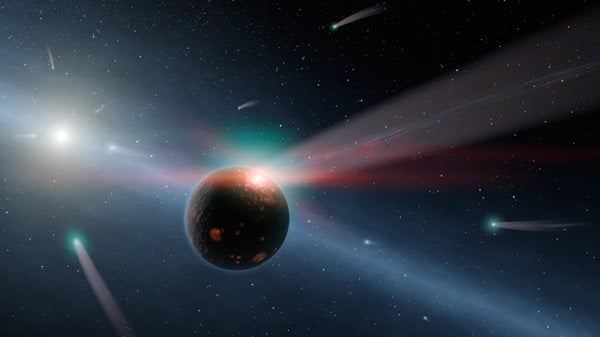Rogue worlds the size of the Moon and Mars may lurk in vast numbers in interstellar space, researchers say. However, rogue planets the size of Earth are probably rare, scientists added.
Previous research found that when planetary systems form, a good number of worlds may not stay bound to their parent star, but instead get flung into deep space. Astronomers have already discovered a handful of such free-floating worlds (sometimes called “rogue planets”), such as 2MASS J1119–1137, which is four to eight times the mass of Jupiter and is about 95 light-years from Earth.
Starless planets may not be rarities. “A startling result made a few years ago was that there are as many as one or two free-floating Jupiter-size planets per star,” says astrophysicist Thomas Barclay at NASA Ames Research Center in California.
So far the known orphan worlds have all been ones large enough for current observatories to discover in the vast spaces between the stars — gas giants like Jupiter and Saturn, instead of rocky planets like Earth and Mars. Still, the upcoming Wide Field Infrared Survey Telescope (WFIRST), an infrared space observatory that NASA plans to launch in the 2020s, “could find Earth-mass and potentially Mars-mass material,” Barclay said.
To see how many rocky nomad worlds might exist, researchers developed computer models simulating a star the mass of the sun surrounded by 26 planetary embryos each roughly one-tenth Earth’s mass and 260 planetesimals each about one-hundredth Earth’s mass. (Mars is about 10.7 percent Earth’s mass, while the moon is about 1.2 percent of Earth’s mass.)
The scientists ran 150 simulations where the planetary systems had two giant planets the mass of Jupiter and Saturn and 150 without such gas giants. These simulations each ran for 2 billion years, allowing for all these bodies to gravitationally pull at each other and to collide and stick together or break apart.
In simulated planetary systems without giant planets, “very little mass is ejected,” Barclay said. At most, bodies no larger than a few times the moon’s mass would leave.
In contrast, when stars had giant planets in orbit around them, the powerful gravitational pulls of these massive worlds gave these planetary systems enough energy to sling bodies up to three times the mass of Mars outward to become rogue planets. All in all, these planetary systems ejected about five times Earth’s mass worth of bodies, about half of which were the size of Mars or larger, while the other half were about the moon’s mass.
In simulated planetary systems with giant planets, there were two epochs of ejection, Barclay said. The first epoch occurred during the first few millions to few tens of millions of years of the simulations, and hurled out relatively pristine primordial material. The second epoch happened about 100 million years into simulations, consisted of the results of impacts between bodies, and included larger bodies that formed from these collisions.
All in all, “we expect to find something like seven or eight Mars-mass free-floating planets per star in the galaxy,” Barclay said. “If giant planets are common, we’ll find many; if giant planets are rare, we’ll find few. Our theoretical study has strong predictions that can be tested with future observations currently being planned.”
However, “very few to none rogue planets were Earth-mass,” Barclay said. This was primarily because most bodies were ejected before the timescales needed to grow an Earth-mass world.
Although these simulations were run with Sun-like stars, “we wouldn’t expect to see very big differences for different stellar types,” Barclay said. “However, we do want to run simulations to confirm this suspicion.”
Barclay cautioned that scientists “still don’t have a fantastic model of how the solar system formed, and even worse models of how other planetary systems formed,” Barclay said. “Learning more about rogue planets could help us learn more about how planetary systems form — what’s kept in, and what’s tossed out.”
Barclay and his colleague Elisa Quintana detailed their findings Oct. 19 at the American Astronomical Society Division for Planetary Sciences and European Planetary Science Congress in Pasadena, California.










